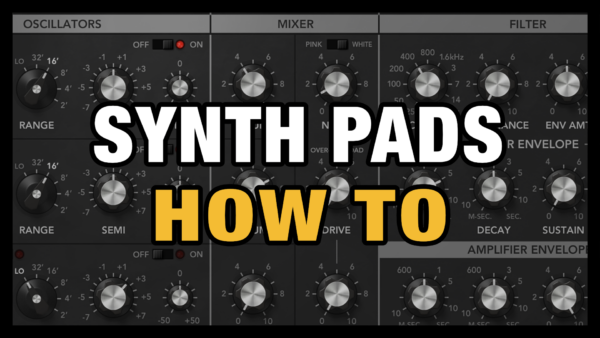 Synth pads is one of the most fundamental types of sounds used in music, because they can add another dimension in the background of your music.
Synth pads is one of the most fundamental types of sounds used in music, because they can add another dimension in the background of your music.
Pads can often be warm, soft and distant…but you can also make them brighter and more magical/shimmering in the high range.
Here are my 7 top tips on how you can create and shape your own pad sounds, using any synth:
How to make Synth Pads?
- Start with a Rich Sounding Waveform (you can also layer waveforms)
- Use a Long Attack and Release time on the Amp-Envelope.
- Low Pass Filter to Make the Pad Softer.
- Map the MOD-wheel to open up the filter.
- Slowly open up the filter with the Filter-Envelope.
- Add movement with an LFO (ex: panning, FX etc.).
- Enhance the Depth with a Huge Reverb.
Start with a Rich Sounding Waveform
I recommend using waveforms that have a rich sound already in their harmonic content, so not sine waves or triangle wave, but rather saw waves and more complex waveforms. You can then of course layer more waveforms (oscillators) for more variation.¨
Use a Long Attack and Release time
Pads are all about that soft attack and long tail after you release the notes. So a good starting point is to set the Attack Time and Release Time on the Amp-envelope to at least 1 second or more.
Low Pass Filter to Make the Pad Softer
Turn on the filter, and apply a low-pass mode. Then adjust the cut-off frequency and slope setting (dB/octave) for as much soft character as you want your pad sound to have.
Map the MOD-wheel to open up the filter
I recommend mapping the MOD-wheel to the filter, so you can create dynamic swells and curves in your music. You could also map other parameters to the MOD-wheel as well, to add even more tonal variation when you perform/automate the MOD-wheel.
Slowly open up the filter with the Filter-Envelope
A classic way to add that soft wave type of sound for synth pads, is to start with the low-pass filter at a very low setting, then use the filter-envelope to increase cut-off frequency over time. You can then shape the timing of this “filter wave” with your filter-envelope, and the depth of its impact with the “envelope” dial on the filter itself.
Add movement with an LFO
To make your pads more organic and alive, I recommend mapping an LFO (or several) to one or more parameters in your synth. For example, panning, various FX, tuning etc. You can also add movement with extra effects like tremolo, rotary speakers, phasers etc.
Enhance the Depth with a Huge Reverb
Finally it’s time to make your pad deeper and more distant. This is where you can add a big reverb preset. You can also experiment with unison, harmonic doubling, chorus etc. for making your pad sound richer and wider.
